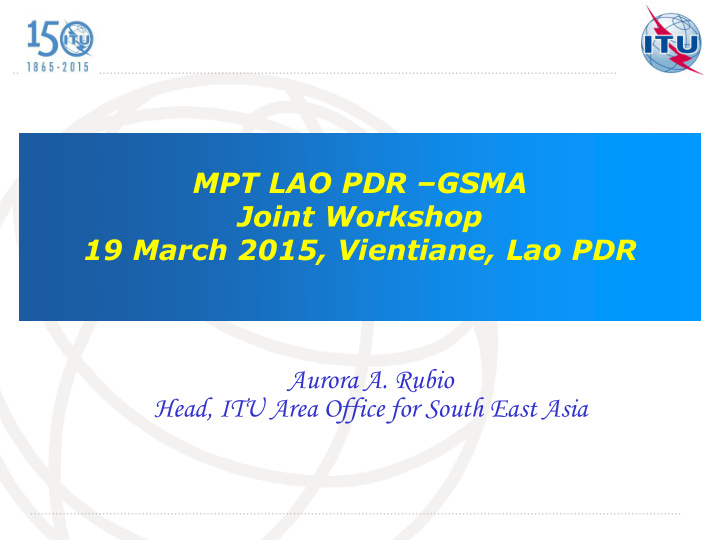



MPT LAO PDR – GSMA Joint Workshop 19 March 2015, Vientiane, Lao PDR Aurora A. Rubio Head, ITU Area Office for South East Asia
Harmonized Cross-Border RF Interference Mitigation Approach for ASEAN Objective To develop a harmonized common approach/procedures/framework in ASEAN Member Countries that predicts possible interferences among different services and provide proper protection for existing networks, stations or links and for future services.
Why Harmonized Cross-Border RF Interference Mitigation Approach for ASEAN ? RF cross border interference is a Global Issue BUT requires regionally harmonized approaches adopted to resolve the issue. “ HCM Agreement ” is the name used to designate the Existing Examples Globally: Agreement between the authorities of Austria, Belgium, the Czech Republic, Germany, France, Hungary, the Netherlands, Croatia, Italy, Liechtenstein, Lithuania, Luxembourg, Poland, Romania, the Slovak Republic, Slovenia • Harmonized Calculation Method (HCM) and Switzerland, regarding the co-ordination of frequencies Agreement covering 17 countries of Europe. between 29.7 MHz and 39.5 GHz for the Fixed Service and the Land Mobile Service in accordance with Article 6 of the ITU Radio Regulations. • HCM 4A (HCM for Africa): Based on HCM The HCM Agreement provides for detailed administrative agreement but developed in accordance with procedures concerning frequency co-ordination and also includes technical provisions. A software has been regional (Sub-Saharan Africa) requirements developed to ensure harmonized use of the calculation methods laid down in the Agreement.
Cross Border RF Interference Mitigation • Some Facts of South East Asian Countries • Significant population concentration on the border areas of countries in e.g. Cambodia - Lao P.D.R – Thailand - Vietnam etc. • Interference issues exist and is primarily due to lack of comprehensive formal agreement on the management of said issues, including harmonized calculation methods at regional and/or sub-regional level. • Some Examples of Sub-regional approaches in ASEAN to address the issue • Indonesia-Malaysia-Singapore under the trilateral forum between the three countries; • Singapore-Malaysia-Brunei using Frequency Assignment and Coordination, Singapore, Malaysia and Brunei Darussalam (FACSMAB) platform. • Bilateral agreements of Lao P.D.R with Vietnam and Thailand separately.
Scope of Activities of Project 1. Assessment Phase Review of existing bilateral and multilateral cross-border frequency coordination agreements / procedures / practices / frameworks in ASEAN countries. 2. Development of procedures: Based on the deliverables of assessment phase, recommend a common administrative set of procedures and the relevant technical Annexes based on the HCM Agreement 3. Creation of a Technical Working Group (TWG) on cross-border frequency coordination comprising of the nominated Spectrum Managers from ASEAN member countries. 4. Validation workshop and adoption of the recommendations of TWG including development and adaptation of a common software tool considering existing Agreement/ procedures / guidelines / practices in other regions of the world. 5. Finalization of software/tools and regional training workshop(s)
I Thank U www.itu.int www.itu.int/ITU-D/asp/CMS/index.asp
Recommend
More recommend